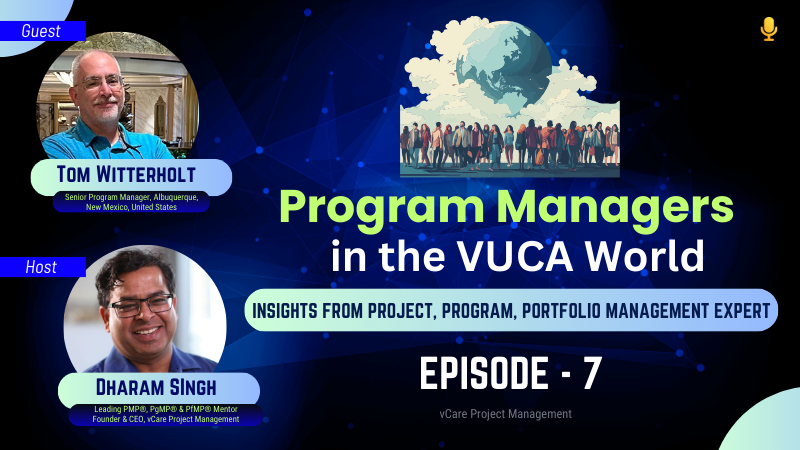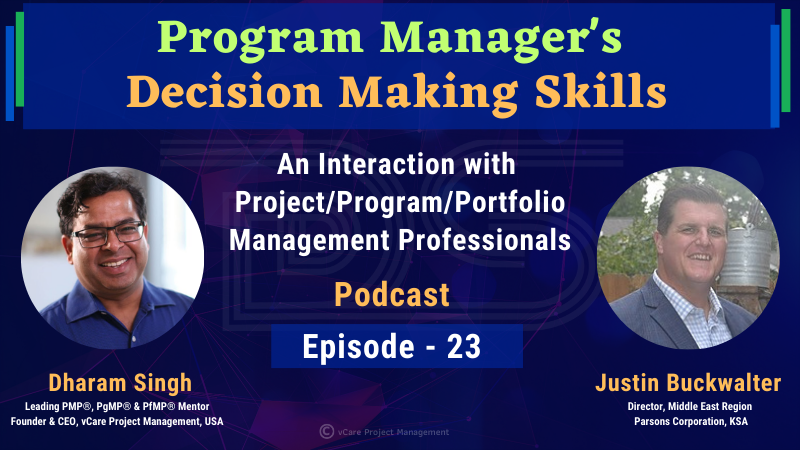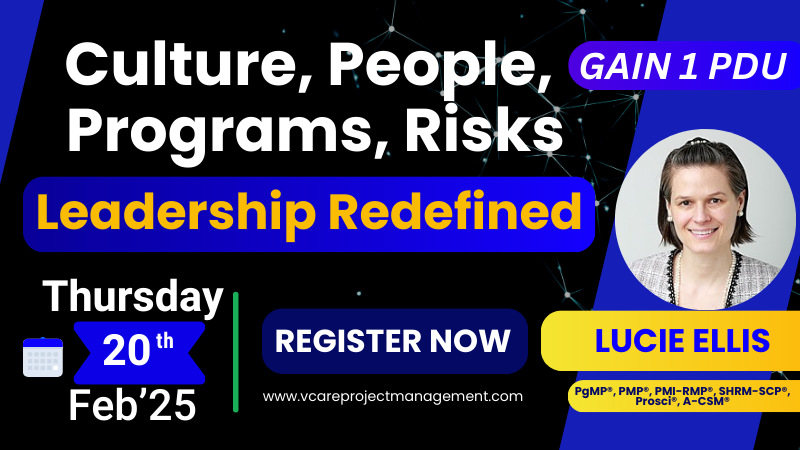
by DharamCW | Feb 24, 2025 | Uncategorized
🚀 Elevate Your Project Portfolio Management Expertise! | Exclusive Webinar with Marcelo Pessotto, MBA, PfMP, PMP, PRINCE2
Are you ready to turn business goals into reality with strategic portfolio management?
Join me for an exclusive live webinar featuring Marcelo Pessotto, a highly respected IT Project, Program, and Portfolio Management professional with over two decades of experience from Orlando, Florida, USA.
🔗 Reserve Your Spot Now: https://bit.ly/4hhH4Yu
📅 Session Date: Thursday, March 6, 2025
⏰ Session Time:
09:30 AM – 10:30 AM (PST) / 10:30 AM – 11:30 AM (MST) / 11:30 AM – 12:30 PM (CST) / 12:30 PM – 01:30 PM (EST) / 02:30 PM – 03:30 PM (BRT) / 05:30 PM – 06:30 PM (GMT) / 06:30 PM – 07:30 PM (CET) / 08:30 PM – 09:30 PM (AST) / 09:30 PM – 10:30 PM (GST)
🎯 Key Takeaways from the Webinar:
✔ Navigating Complex Stakeholder Ecosystems in High-Stakes Projects
✔ Avoiding Pitfalls in Translating Business Strategies into Actionable Portfolios
✔ Redefining Success: Beyond ROI and Time-to-Market in Portfolio Management
✔ Balancing Innovation and Stability in High-Risk Portfolio Environments
✔ Integrating Squad-Based Teams into Traditional Portfolio Structures
✔ Transforming Vision into Reality: Grounded Strategies for Long-Term Success
✔ The Power of Empathy in Managing Multicultural Teams for Customer-Focused Success
✔ Embedding Sustainability in Modern Portfolio Management Practices
💡 Bonus for Attendees: Earn 1 Professional Development Unit (PDU) and get access to a special discount code for our upcoming PMP, PgMP, PfMP, and PMI-ACP programs.
📞 Have Questions About Your Project Management Career?
You can book a free 15-minute consultation with me to discuss training, certifications, and career growth in PMI certifications.
👉 Schedule here: http://talktodharam.com
🎥 Want to Stay Updated with Project Management Insights?
🔔 Subscribe to vCare Project Management YouTube Channel for Q&A sessions, certification success stories, and expert discussions. 🔗 https://bit.ly/2YF0wJl
🎙️ Follow My Podcasts & Expert Interviews:
🔗 https://bit.ly/2NDY8wd
💬 Which challenge do you face the most in managing portfolios? Drop your thoughts below! 👇
#PgMP #PfMP #PMP #vCareProjectManagement #DharamSinghPfMP #DharamSinghPgMP #PortfolioManagement #ProgramManagement #PMICertification #StakeholderEngagement #MarceloPessotto

by DharamCW | Feb 15, 2025 | Uncategorized

by DharamCW | Feb 12, 2025 | Leadership in Project Management, Podcast, Project-Program-Portfolio Management Knowledge
Program Managers Decision Making Skills | Justin Buckwalter | Program Management Insights Episode 23
🎥 Watch now: https://www.youtube.com/watch?v=MkmY_BJYEik
📚 Discussion Topics:
– Reflecting on Peter Drucker’s quote: “Whenever you see a successful business, someone once made a courageous decision.” How do you make courageous decisions in program management to navigate uncertainty and ensure project success?
– How do you address behavioural biases and analysis paralysis to ensure efficient and timely decision-making in your program management practice?
– Considering the World Economic Forum’s ‘Future of Jobs Report 2023’, which identifies critical thinking and decision-making as top skills for future professionals, how do you and your team strengthen these skills, and what decision-making frameworks or practices do you find most valuable in program management?
– How do you integrate feedback mechanisms across your program management practice to improve decision-making, and what broader lessons can you share from this process?
– Michael Porter often emphasized that “the essence of strategy is choosing what not to do.” How do you prioritize program objectives and decide what to exclude to ensure strategic alignment while balancing stakeholder expectations and resource constraints?
– What initiatives are companies taking to balance the integration of AI and machine learning with traditional decision-making processes in program management?
– How does ethical leadership influence success in contemporary projects, and what traits are organizations prioritizing in their leadership development programs?
– Regarding upskilling, what specific programs or training do you see as most beneficial for program managers to enhance their decision-making capabilities in the face of rapid technological change?
– How are current trends and challenges in program management influencing the strategic priorities of organizations, and what steps are being taken to equip managers with the skills needed for future challenges?
🚀 Looking to deepen your knowledge? Check out our upcoming webinars featuring global experts,
1. Culture, People, Programs, Risks: Leadership Redefined featuring Lucie Ellis – https://bit.ly/3VXv4mW
2. Turning Business Goals into Reality featuring Marcelo Pessotto – https://bit.ly/4hhH4Yu
3. Resilient Leadership in Cyber-Driven Programs: Strategies from a Transformation Expert featuring Dr. Maria Sette – https://bit.ly/4j9fmPA
– Book an obligation-free consultation session on Project management Career, training, and certifications: http://talktodharam.com
#ProgramManagement #DecisionMaking #LeadershipDevelopment #PgMP #PfMP #PMP #StrategicLeadership #ProjectSuccess #CriticalThinking #ProgramManager #StakeholderEngagement #AIIntegration #EthicalLeadership #FutureOfWork #RiskManagement #AskDharam #VCareProjectManagement

by DharamCW | Feb 10, 2025 | Professional Development Webinars
Culture, People, Programs, Risks: Leadership Redefined | Lucie Ellis | vCare PgMP Success Story
Join me for an extraordinary webinar with Lucie Ellis, SHRM-SCP, PgMP, RMP, Prosci, PMP, A-CSM, MS, an internationally acclaimed Senior Executive Leader and Portfolio Director from New York, USA, who will be the keynote speaker. This webinar is designed to inspire and empower senior professionals in project, program, and portfolio management.
Key topics include:
• Leadership Strategies for Integrating People, Programs, and Risks for Long-Term Success
• Future Trends and Emerging Technologies in Portfolio and Program Management Leadership
• Human-Centered Leadership in Risk Management and Organizational Culture Development
• Leveraging Empathy and Communication to Build High-Performing Teams
• Cultural Considerations in Global Risk Management and Program Execution
• Aligning Portfolio and Program Objectives with Organizational Strategic Goals Using KPIs and Benchmarks
Attendees will benefit from Lucie’s expertise while earning 1 PDU and a special discount on vCare’s upcoming PMP®, PgMP®, and PfMP® programs. Don’t miss this chance to redefine leadership and elevate your career!
🔗 Reserve your spot now: https://bit.ly/3VXv4mW
Session Date: Thursday, 20th February 2025
Session Time: 10:00 AM – 11:00 AM (PST) / 12:00 PM – 01:00 PM (CST) / 11:00 AM – 12:00 PM (MST) / 01:00 PM – 02:00 PM (EST) / 03:00 PM – 04:00 PM (BRT) / 06:00 PM – 07:00 PM (GMT) / 07:00 PM – 08:00 PM (CET) / 09:00 PM – 10:00 PM (AST)
🚀 Elevate Your Project Management Career:
– Book an obligation-free consultation session on Project Management Career, training, and certifications: http://talktodharam.com
– Discover training offers and certification discounts: https://bit.ly/3jWVepD
– Stay updated with our Q&A series and certification success stories by subscribing to the vCare Project Management YouTube channel at https://bit.ly/2YF0wJl
– Follow my podcasts and interviews with Project Management Experts on YouTube at https://bit.ly/2NDY8wd
#LeadershipRedefined #PgMPWebinar #ProgramManagement #PortfolioManagement #RiskManagement #ProjectLeadership #HumanCenteredLeadership #EmpathyInLeadership #AskDharam #DharamSingh

by DharamCW | Jan 24, 2025 | Program Management, Project Management
Driving Business Viability Through Benefits Management | Tom Witterholt | Dharam | PMI PgMP | Episode 8
How can a Program Manager improve business viability through effective benefits management inside and outside the company?
– Delivering Value – Benefits Management
– Internal Program Benefits vs. External Program Benefits
Video Link: https://www.youtube.com/watch?v=WLqRW70gmfI
🚀 Looking to deepen your knowledge? Check out our upcoming webinars featuring global experts,
1. PMO Digital Transformation Leadership: Insights and Success featuring Sherwyn Cambridge – https://bit.ly/4iMvyWE
2. Culture, People, Programs, Risks: Leadership Redefined featuring Lucie Ellis – https://bit.ly/3VXv4mW
3. Resilient Leadership in Cyber-Driven Programs: Strategies from a Transformation Expert featuring Dr. Maria Sette – https://bit.ly/4j9fmPA
– Book an obligation-free consultation session on Project management Career, training, and certifications: http://talktodharam.com
– Discover training offers and certification discounts: https://bit.ly/3jWVepD
– Stay updated with our Q&A series and certification success stories by subscribing to the vCare Project Management YouTube channel at https://bit.ly/2YF0wJl
– Follow my podcasts and interviews with Project Management Experts on YouTube at https://bit.ly/2NDY8wd
#ProgramManagement #BenefitsManagement #PMI #PgMP #BusinessViability #DeliveringValue #BusinessSuccess #StrategicManagement #ValueCreation #InternalBenefits #ExternalBenefits #ProjectManagement #BusinessTransformation #CorporateStrategy #ProgramSuccess #ProgramManager #AskDharam #DharamSingh #DharamSinghPgMP #DharamSinghPfMP #TomWitterholt #DharamSinghPMP #vCareProjectManagement











Are Program Managers ready to accept the challenges and offer solutions to address emerging realities in the VUCA world?
– What is VUCA?
– Navigating Uncertainties
– Upskilling – Today & Future
– Why Program Managers Must Stay Informed
– Stakeholders Communication